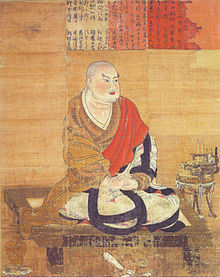Kuiji
 | |
| Personal | |
| Born | Yuchi (surname) Hongdao (style) 632 |
| Died | 682 (aged 50) |
| Religion | Buddhism |
| Parents |
|
| School | East Asian Yogācāra |
| Senior posting | |
| Teacher | Xuanzang |
Kuījī (traditional Chinese: 窺基; simplified Chinese: 窥基; Japanese: Kiki; Korean: Kyugi; 632–682), also known as Ji (Chinese: 基),[2] an exponent of Yogācāra, was a Chinese monk and a prominent disciple of Xuanzang.[3] His posthumous name was Cí'ēn dàshī (慈恩大師; 'Master Ci'en'), The Great Teacher of Cien Monastery, after the Daci'en Temple or Great Monastery of Compassionate Grace, which was located in Chang'an, the main capital of the Tang Dynasty. The Giant Wild Goose Pagoda was built in Daci'en Temple in 652. According to biographies, he was sent to the imperial translation bureau headed by Xuanzang, from whom he later would learn Sanskrit, Abhidharma, and Yogācāra.[4]
Kuiji collaborated closely with Xuanzang on the Cheng weishi lun, a redacted translation of commentaries on Vasubandhu's Triṃśikā-vijñaptimātratā.[4] Kuiji's commentaries on the former text, the Cheng weishi lun shuji, along with his original treatise on Yogācāra, the Dasheng Fayuan yilin chang (大乘法苑義林章; "Essays on the Forest of Meanings in the Mahāyāna Dharma Garden") became foundations of the Faxiang School, the dominant school of Yogācāra thought in East Asia.[3] He is accordingly considered the founder of this school which differed notably from Paramārtha's earlier Chinese Yogācāra system. Kuiji is also known for his commentaries on Dharmapāla's Yogācāra philosophy.[4]
Works[edit]
Mahayana Sutra Commentaries[edit]
- Amitābha and Maitreya Sūtras
- Diamond Sūtra
- Heart Sūtra (般若波羅蜜多心經幽贊). Translated by Shih and Lusthaus (2006).
- Lotus Sūtra (Fahua xuanzan, "Profound Panegyric to the Lotus Sūtra")[4]
- Vimalakīrtinirdeśa-sūtra (說無垢稱經疏)
Pramana[edit]
- Great Commentary on the Nyayapravesa (因明入正理論疏)
Commentaries on Yogacara treatises[edit]
- Cheng weishi lun shuji (成唯識 論述記; Taishō no. 1830, vol. 43, 229a-606c), a commentary on Xuanzang's Cheng weishi lun
- Madhyāntavibhāga (辯中邊論述記)
- Sthiramati's Commentary on Asaṅga's Abhidharmasamuccaya (雜集論述記)
- Vasubandhu's Twenty Verses (Viṃśatikā) (唯識二十論述記))
- Vasubandhu's One Hundred Dharmas Treatise (大乘百法明門論解)
- Yogācārabhūmi (瑜伽師地論略纂)
Notes[edit]
- ^ De Visser, Marinus Willem (1935). Ancient Buddhism in Japan. E. J. Brill. p. 442.
- ^ "中国历史上排名第二的高僧究竟叫什么名字?" (in Chinese). The Paper. 20 December 2015. Retrieved 20 December 2015.
- ^ a b Lusthaus, Dan (undated). Quick Overview of the Faxiang School (法相宗). Source: [1] (accessed: December 12, 2007)
- ^ a b c d Buswell, Robert Jr; Lopez, Donald S. Jr., eds. (2013). Princeton Dictionary of Buddhism. Princeton, NJ: Princeton University Press. p. 291. ISBN 9780691157863.
References[edit]
- Shih, Heng-Ching & Lusthaus, Dan. (2006) A Comprehensive Commentary on the Heart Sutra (Prajnaparamita-hyrdaya-sutra). Numata Center for Buddhist Translation & Research.
- Lusthaus, Dan (undated). Quick Overview of the Faxiang School (法相宗). Source: [2] (accessed: December 12, 2007)
- Katsura, Shoryu (2014). The Theory of Apoha in Kuiji’s "Cheng weishi lun Shuji" (Katsura, Shoryu). In Lin, Chen-kuo , Radich, Michael (eds), A Distant Mirror - Articulating Indic Ideas in Sixth and Seventh Century Chinese Buddhism, Hamburg Buddhist Studies vol. 3, Hamburg University Press. pp. 101-120
